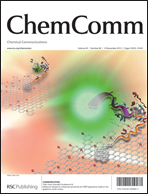A unique carbon with a high specific surface area produced by the carbonization of agar in the presence of graphene†
Abstract
A unique carbon with a high specific surface area was prepared by carbonization of a polymer-based precursor, agar, in the presence of graphene. Graphene prevents the shrinkage and aggregation of the carbonized particles, resulting in extraordinarily large external surface area (∼1200 m2 g−1) of the carbon, which shows a high rate performance as a supercapacitor electrode.


 Please wait while we load your content...
Please wait while we load your content...